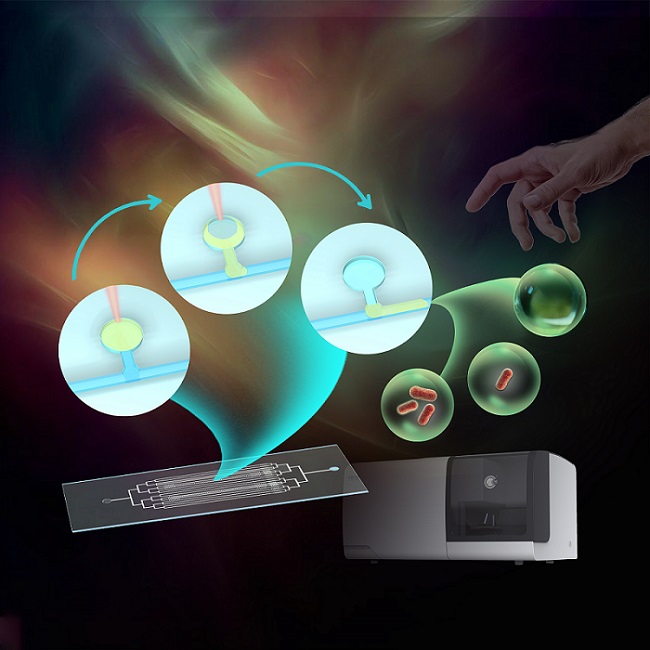An on-demand optical system for exporting target droplets from a static droplet array (SDA) provides a simple way to export specific cells or analytes for analysis without compromising efficiency or accuracy. Researchers at the Qingdao Institute of Bioenergy and Bioprocess Technology of the Chinese Academy of Sciences developed the system, called optical on-demand droplet release (OODR). The developers and their collaborators believe that OODR could promote SDAs as a valuable tool for use with high-capacity screening assays with applications in diverse fields. They said that the technique in its current stage of development has the potential to be used in single-molecule/cell analysis, drug screening, and phenotype-based cell sorting.
The OODR system incorporates a 1064-nm laser-responsive indium tin oxide (ITO) layer into a microchamber, array-based, droplet microfluidic chip. When the laser is focused onto the ITO layer of the chip, local heating causes microbubbles to form. The microbubbles push the droplets out of the chamber on a selective basis.

The optical on-demand droplet release (OODR) system based on EasySort Compact could be used for high-capacity screening assays in a diverse array of fields including cell analysis, drug screening, and phenotype-based cell sorting. Courtesy of Yang Liu.
The researchers fabricated the chip using a low-cost, readily available ITO glass as a photoresponsive layer. The ITO layer was bonded to a PDMS layer with an array of microchambers to provide the capability to selectively release target droplets and enable the SDA to work rapidly.
According to the researchers, the size of the microbubble proved to be critical to the successful release of the droplet based on the chip design used by the team. They identified the optimal size for the microbubble as 40 μm, and they tuned the laser to the range necessary to generate the amount of heat needed to form a correctly sized microbubble without degrading the integrity of the cell. Under the appropriate conditions, OODR can release a droplet within three seconds.
OODR precisely heats the ITO layer, via laser, to create microbubbles that allow for the selective pushing of a target droplet out of the chamber on the microfluidics chip. This is based on the microdroplet single-cell sorting system, such as EasySort Compact, for example. The team used the EasySort Compact system to achieve automatic single-cell sorting, said professor Bo Ma.

Once the released droplet is pushed out of the chamber, it is carried by the flow to the outlet. The droplet can be easily exported in the one-droplet-one-tube (ODOT) manner by a pipette tip, via the inherent capillary force, which allows the movement of liquid without applying external force. The droplet is exported into a well or tube in a high-throughput manner for further analysis.
The released droplet is identified by using white or fluorescent imaging. These images can be used to sort the morphology of the target bacteria, which can be a challenge without a static image for reference.
The researchers used OODR to selectively release droplets containing fluorescein sodium from an SDA consisting of 6400 microchambers. OODR achieved a success rate of about 100% (nine out of 6400 droplets were successfully released). It also exhibited low residual, with only about 5% of the droplet volume remaining in the chamber.
The team demonstrated on-demand release of single-cell and multicell droplets for both E. coli and yeast, based on white or fluorescence imaging. The successful use of OODR with E. coli and yeast cells suggests that the system is applicable to other types of cells. According to Ma, the technique not only targets single cells, but enables the sorting of microdroplets that contain one cell, multiple cells, and/or reagents only.
Beyond avoiding causing any effect to the cell’s ability to be cultivated, or accuracy, the researchers said, the successful cultivation of the cell-containing droplets in an ODOT manner indicates that the isolation method has minimal impact on cell viability. This, they said, is essential when further live-cell analyses are needed. It also demonstrates the potential to seamlessly couple OODR with downstream ODOT-based assays, such as human or microbial single-cell sequencing. OODR also reduces the sample size and amount of reagent needed for analysis, making SDA more efficient and cost-effective. And the current system is user-friendly, the researchers said.
Professor Jian Xu said that the team is currently using artificial intelligence and machine learning to automate the system via EasySort. This will reduce human involvement in the system’s operation, making it easier for nonprofessionals to use, which could further expand the use of OODR and SDA.
The research was published in Biosensors & Bioelectronics (www.doi.org/10.1016/j.bios.2023.115639).